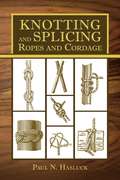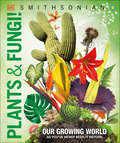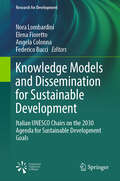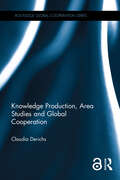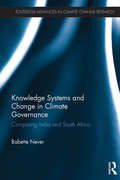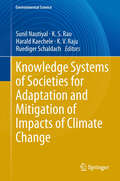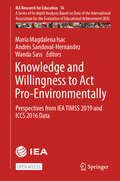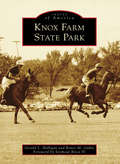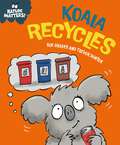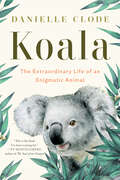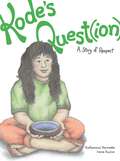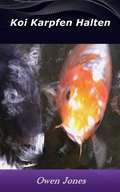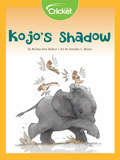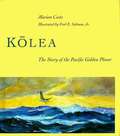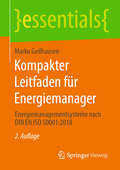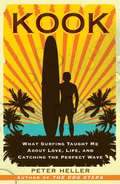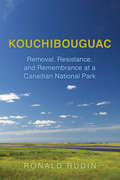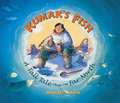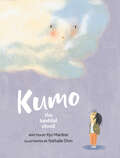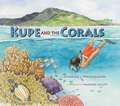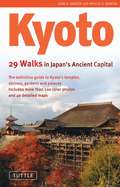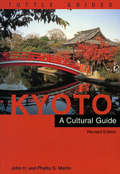- Table View
- List View
Knotting and Splicing Ropes and Cordage: With Numerous Engravings And Diagrams (classic Reprint)
by Paul N. HasluckWhen it comes to explaining crafters' tools and techniques, craftsman Paul N. Hasluck is a true master. In Knotting and Splicing Ropes and Cordage, Hasluck covers everything, from the basics of rope formation to trying useful knots, splicing rope, working cordage, tying fancy knots, using different ties and lashings, and more--all among more than 200 intricate illustrations. Great for sailors, Scouts, climbers, cavers, rescue workers, or anyone who is simply interested in learning the skills behind knotting and splicing, this classic work holds the very foundation of the art.
Knowledge Encyclopedia Plants and Fungi
by DKExplore the wonderful world of plants and fungi, with everything from cacti and carnivorous plants to trees, flowers, and mushrooms.Why are flowers colorful and fruits sweet? How does a carnivorous plant kill its prey? Why do stinging nettles sting? How do trees turn light into food? This ultimate nature book for children will fascinate young readers with its microscopic detail and amazing facts on the plant world. Children aged 9+ will find themselves totally absorbed in the complexities nature, made clear through engaging explanations, intricate illustrations, vivid photographs, and striking 3D images. Knowledge Encyclopedia: Plants and Fungi! teaches kids all about plants and fungi by showing how they work with beautiful illustrations. Peer inside a leaf, watch a seed sprout, follow a root underground, and see how a flower becomes a fruit.This all-encompassing nature encyclopedia for kids offers: A whole collection of facts, charts, timelines, and illustrations that cover a vast range of topics.Plants and fungi from around the world shown using amazingly detailed CGIs that entice young readers to dive in and explore.Important STEM topics covered in life sciences curricula.A visual approach using illustrations, photographs and extremely detailed 3D CGI images.Knowledge Encyclopedia: Plants and Fungi! shows how plants and fungi form the foundations of every ecosystem, making our planet habitable. Life on Earth couldn&’t exist without plants and fungi. Plants create the food we eat and the oxygen we breathe. They regulate the climate, provide habitats for animals, and produce sustainable resources that we can use to make books, clothes, furniture and houses. Fungi are just as important.Every page is packed with incredible facts and statistics. Did you know that the seeds of the Australian snottygobble plant don&’t grow until they&’ve been pooed out by emus? Or that the world&’s oldest tree began growing before the pyramids were built?More in the SeriesKnowledge Encyclopedia Plants and Fungi! is part of DK&’s visual and informative Knowledge Encyclopedia series. Complete the collection and dive into the deep with Knowledge Encyclopedia Ocean!, take a trip to the solar system with Knowledge Encyclopedia Space! and travel back to prehistoric times with Knowledge Encyclopedia Dinosaur!
Knowledge Models and Dissemination for Sustainable Development: Italian UNESCO Chairs on the 2030 Agenda for Sustainable Development Goals (Research for Development)
by Nora Lombardini Elena Fioretto Angela Colonna Federico BucciThis book delves into the invaluable contributions made by the Italian UNESCO Chairs toward addressing the intricate and pressing global challenges of our era. Established within the UNITWIN/UNESCO Chairs program initiated by UNESCO in 1992, these Chairs serve as vital links between the realms of academic research and civil society. They offer a conduit for disseminating knowledge, thereby advancing the objectives of global development. By facilitating the transfer and adoption of scientific methodologies through intellectual collaboration, they strive to enhance the sustainability and resilience of both individual communities and society at large. Through a series of dialogues, the Italian UNESCO Chairs critically examine the challenges inherent in this mission, the objectives they aim to achieve, the strategies employed in scientific research, and the development of novel areas of study. They approach these endeavors with a conscientious and responsible mindset, recognizing them as essential responses to the multifaceted issues arising in our rapidly evolving world. The contributions put forth by the Italian UNESCO Chairs serve as practical tools for the implementation of the 17 Sustainable Development Goals, making them relevant to various stakeholders. These include not only citizens, scholars, public and private institutions, research centers, and administrators but also anyone with an interest in tackling the challenges of sustainable development in our everyday lives.
Knowledge Production, Area Studies and Global Cooperation (ISSN)
by Claudia DerichsWhereas Area Studies and cross-border cooperation research conventionally demarcates groups of people by geographical boundaries, individuals might in fact feel more connected by shared values and principles than by conventional spatial dimensions. Knowledge Production, Area Studies and Global Cooperation asks what norms and principles lead to the creation of knowledge about cross-border cooperation and connection. It studies why theories, methods, and concepts originate in one place rather than another, how they travel, and what position the scholar adopts while doing research, particularly ‘in the field’.Taking case studies from Asia, the Middle East and North Africa, the book links the production of alternative epistemologies to the notion of global cooperation and reassesses the ways in which the concept of connectedness can be applied at the translocal and individual rather than the formal international and collective level.Knowledge Production, Area Studies and Global Cooperation provides an innovative and critical approach towards established means of producing knowledge about different areas of the world, demonstrating that an understanding of pluri-local connectivity should be integrated into the production of knowledge about different areas of the world and the behavioural dimension of global cooperation. By shifting the view from the collective to the individual and from the formal to often invisible patterns of connectedness, this book provides an important fresh perspective which will be of interest to scholars and students of Area Studies, Politics, International Relations and Development Studies. The Open Access version of this book, available at http://www.taylorfrancis.com, has been made available under a Creative Commons Attribution-Non Commercial-No Derivatives (CC-BY-ND) 4.0 license.
Knowledge Systems and Change in Climate Governance: Comparing India and South Africa (Routledge Advances in Climate Change Research)
by Babette NeverThe success of international efforts to manage climate change depends on the participation of emerging economies. This book uses a comparative study of two of the most important, India and South Africa, to reveal new insights into managing climate change on a global scale. The book provides a unique in-depth analysis of how these two countries are dealing with climate change at both national and province levels, from India’s advances in solar and wind energy development to South Africa’s efforts to introduce a carbon tax. Using the innovative theoretical framework of climate knowledge systems, it explores how people in India and South Africa engage with one other, learn and act by forming communities of practice. The book identifies the drivers and barriers of climate governance, showing how different forms of scientific, technological, normative and pragmatic knowledge can aid climate governance and analysing how the underlying mind-set that guides climate action in these countries is changing. This book is a valuable resource for students and scholars of environmental policy, politics and governance, as well as comparative politics, climate change and sustainable development.
Knowledge Systems of Societies for Adaptation and Mitigation of Impacts of Climate Change
by K. V. Raju Sunil Nautiyal Ruediger Schaldach Harald Kaechele K. S. RaoClimate change is broadly recognized as a key environmental issue affecting social and ecological systems worldwide. At the Cancun summit of the United Nations Framework Convention on Climate Change's 16th Conference, the parties jointly agreed that the vulnerable groups particularly in developing countries and whose livelihood is based on land use practices are the most common victims as in most cases their activities are shaped by the climate. Therefore, solving the climate dilemma through mitigation processes and scientific research is an ethical concern. Thus combining the knowledge systems of the societies and scientific evidences can greatly assist in the creation of coping mechanisms for sustainable development in a situation of changing climate. International Humboldt Kolleg focusing on "knowledge systems of societies and Climate Change" was organized at ISEC. This event was of unique importance, as the year 2011-12 was celebrated as the 60th Anniversary of Diplomatic Relations between India and Germany with the motto "Germany and India - Infinite Opportunities." This volume is the outcome of the papers presented during the IHK 2011 at ISEC, India.
Knowledge and Willingness to Act Pro-Environmentally: Perspectives from IEA TIMSS 2019 and ICCS 2016 Data (IEA Research for Education #16)
by Andrés Sandoval-Hernández Maria Magdalena Isac Wanda SassThis open access book utilizes data from two large-scale international assessments—TIMSS 2019 and ICCS 2016—to investigate the extent to which education for sustainable development outcomes is conveyed and accomplished within various educational systems. Specifically, it aims to expand the understanding of how students' environmental knowledge levels and their willingness to act in a pro-environmentally manner can differ across and within countries. The book also examines whether certain opportunities to learn about environmental issues in secondary schools show promise in enhancing young people's environmental knowledge and attitudes.
Knox Farm State Park
by Renee M. Oubre Gerald L. HalliganA stone wall along Seneca Street in East Aurora, New York, welcomes visitors to Knox Farm State Park with its charming buildings, woodlands, and open fields. The farmland was purchased by Seymour H. Knox, an entrepreneur from Russell, New York. Successful in the five-and-dime store industry with his cousin F.W. Woolworth, Knox expanded his business interests to include raising horses and developing a self-sustaining farm. Following his death in 1915, his family maintained and expanded the property, gracing it with architectural features reflecting their interests. In the 1990s, with the passing of Seymour Knox II and sons, the family's desire to preserve the beloved property was fulfilled with the establishment of Knox Farm State Park.
Koala Recycles (Nature Matters)
by Sue GravesKoala Recycles offers a gentle introduction to the concept of recycling for young children.In this humorous story, Koala isn't good at recycling, and when new recycling bins arrive at school, she cannot be bothered to use them properly. Soon, everyone is feeling cross with her, and she needs to find a way to say sorry! This charming book is the perfect way to introduce young children to the concept of recycling. Also included are suggestions for activities and ideas to talk through together to help children understand the concept.The Nature Matters series of picture books provide a gentle means of promoting concepts of environmental issues, boosting self-esteem and reinforcing good behaviour. Supports the Personal, Social and Emotional Development Area of Learning in the Early Years Foundation Stage, and is also suitable for use with children in KS1 and can be used to discuss citizenship and values. Suitable for children aged 3+.
Koala: A Natural History And An Uncertain Future
by Danielle ClodeA New Scientist Best Popular Science Book of the Year "This is the book I’ve been waiting for." —Sy Montgomery, author of The Soul of an Octopus An Australian biologist delves into the extraordinary world of koalas, from their ancient ancestors to the current threats to their survival. Koalas regularly appeared in Australian biologist Danielle Clode’s backyard, but it was only when a bushfire threatened that she truly paid them attention. She soon realized how much she had to learn about these complex and mysterious animals. In vivid, descriptive prose, Clode embarks on a delightful and surprising journey through evolutionary biology, natural history, and ecology to understand where these enigmatic animals came from and what their future may hold. She begins her search with the fossils of ancient giant koalas, delving into why the modern koala has become the lone survivor of a once-diverse family of uniquely Australian marsupials. Koala investigates the remarkable physiology of these charismatic creatures. Born the size of tiny “jellybeans,” joeys face an uphill battle, from crawling into their mother’s pouch to being weaned onto a toxic diet of gum-tree leaves, the koalas’ single source of food. Clode explores the complex relationship and unexpected connections between this endearing species and humans. She explains how koalas are simultaneously threatened with extinction in some areas due to disease, climate change, and increasing wildfires, while overpopulating forests in other parts of the country. Deeply researched and filled with wonder, Koala is both a tender and inquisitive paean to a species unlike any other and a call to ensure its survival.
Kode's Quest: A Story of Respect (The Seven Teachings Stories)
by Katherena VermetteKode&’s class is learning about the Seven Teachings, but she&’s still confused about Respect. Kode asks the wisest people she knows for help—her parents, her older siblings, and her grandparents. As each person gives her a different answer, Kode learns about the many different ways we can show respect for other people, for the environment, and for ourselves.In this story for young readers, an Anishinaabe girl explores what respect means and how to be a respectful member of a community. A pronunciation guide for the Anishnaabemowin words can be found at the back of the book.Rich in culture and grounded in traditional knowledge, Katherena Vermette&’s The Seven Teachings Stories series features themes of love, wisdom, humility, courage, respect, honesty, and truth. Contemporary Indigenous children explore the Seven Teachings of the Anishinaabe through stories of home and family that will look familiar to all young readers in these books for ages 3–5.
Kode's Quest: A Story of Respect (The Seven Teachings Stories)
by Katherena VermetteKode&’s class is learning about the Seven Teachings, but she&’s still confused about Respect. Kode asks the wisest people she knows for help—her parents, her older siblings, and her grandparents. As each person gives her a different answer, Kode learns about the many different ways we can show respect for other people, for the environment, and for ourselves.In this story for young readers, an Anishinaabe girl explores what respect means and how to be a respectful member of a community. A pronunciation guide for the Anishnaabemowin words can be found at the back of the book.Rich in culture and grounded in traditional knowledge, Katherena Vermette&’s The Seven Teachings Stories series features themes of love, wisdom, humility, courage, respect, honesty, and truth. Contemporary Indigenous children explore the Seven Teachings of the Anishinaabe through stories of home and family that will look familiar to all young readers in these books for ages 3–5.
Koi-Karpfen halten (How to... #1)
by Owen JonesDer Inhalt dieses Buches über Koi Gartenteiche und ähnliche Themen ist auf 18 Kapitel aufgeteilt, welche Ihnen helfen werden, einen Ort für Ihren Koi-Teich auszuwählen, ihn anzulgen und ganzjährlich zu warten und sich um Ihre kostbaren Fische in verschiedenen Jahreszeiten und sogar in besonders schlechten Wetterkonditionen zu kümmern. Es könnte Ihnen sogar dabei helfen, eine neue Karriere zu starten. Das Mindeste, was es tun wird, ist Ihnen hunderte professioneller Ratgeber zu ersparen. Als ein zusätzlicher Bonus gebe ich Ihnen die Erlaubnis, den Inhalt des Buches auf Ihrer Webseite oder Ihrem Blog/Newsletter zu nutzen, obwohl es besser wäre, wenn Sie den Inhalt mit Ihren eigenen Worten wiedergeben würden. Sie können das Buch ebenfalls aufteilen und die Artikel weiterverkaufen. Tatsächlich ist das einzige recht, welches Sie nicht haben der Weiterverkauf oder das Verschenken des Buches, wie Sie es erhalten haben. Wenn SIe Feedback haben, bitte schreiben Sie es bei der Quelle Ihres Kaufes oder senden Sie es mir unter owen@amiabledragon.com Sie können mehr Bücher wie dieses finden, wo Sie es gekauft haben.
Kojo's Shadow
by Na'Ima Bint RobertKojo is a young elephant. When he sees his shadow for the first time, he’s alarmed.
Kolea: The Story of the Pacific Golden Plover (Kōlea)
by Marion Coste Fred SalmonDescribes the physical characteristics, migration, and life cycle of the Kolea or Pacific golden plover, which spends part of its year on the tundra of western Alaska and the remaining months in Hawaii.
Komodo Dragons (Nature's Children)
by Geoff MillerCan Komodo dragons breathe fire? How many teeth do Komodo dragons have? What do young Komodo dragons look like? Find the answers to these questions, and learn much more about the physical characteristics, behavior, habitat, and lives of Komodo dragons. Other books in this series are available in this library.
Kompakter Leitfaden für Energiemanager: Energiemanagementsysteme nach DIN EN ISO 50001:2018 (essentials)
by Marko GeilhausenEnergiemanager und Energiemanagementbeauftragte finden die wesentlichen Aspekte und Anforderungen kompakt und übersichtlich dargestellt. Tabellen geben Beispiele und veranschaulichen die dargestellten Zusammenhänge, gemeinsam mit dem Sachwortverzeichnis bietet sich dieses Buch so zum Überblick und schnellen Nachschlagen für den Praktiker an. Die Änderungen zur Vorgängernorm ISO 50001:2011 sind ebenfalls benannt.
Konflikthafte Vergemeinschaftung: Aushandlung von Vorstellungen einer nachhaltigeren Zukunft in zwei ländlichen Alpengemeinden
by Jana TürkJana Türk untersucht in ihrer qualitativen Studie, wie Akteure in zwei ländlichen Alpengemeinden nachhaltige Entwicklung aushandeln. Dabei nimmt sie unterschiedliche lokale Entwicklungsprozesse in den Blick und rekonstruiert anhand von leitfadengestützten Interviews, ethnographischen Beobachtungen und weiteren Dokumenten kollaborative und konflikthafte Aushandlungsprozesse und welche Rolle Gemeinwohl im Umgang mit den lokal wirksamen Dynamiken sozial-ökologischen Wandels spielt.
Kook: What Surfing Taught Me About Love, Life, and Catching the Perfect Wave
by Peter HellerAuthor of the New York Times bestselling novel The Dog Stars With grit, poetry, and humor, Peter Heller, acclaimed author of The Whale Warriors recounts his remarkable journey of discovery--of surfing, an entirely new challenge; of the ocean's beauty and power; of the strange surf subculture; of love; and, most of all, of how to seek adventure while crafting a meaningful life. Having resolved to master a big-hollow wave-- that is, to go from kook (surfese for beginner) to shredder--in a single year, Heller travels from Southern California down the coast of Mexico in the company of his girlfriend and the eccentric surfers they meet. Exuberant and fearless, Heller explores the technique and science of surfing the secrets of its culture, and the environmental ravages to the stunning coastline he visits. As Heller plumbs the working of his own heart and finds joy in both love and surfing, he affords readers vivid insight into this fascinating world, with all of its perils and pleasures, its absurdity and wonder. Exhilarating, entertaining, and moving, Kook is a love story between a man and his surfboard, a man and his girlfriend, a not-so-old man and the sea.
Kouchibouguac: Removal, Resistance, and Remembrance at a Canadian National Park
by Ronald RudinIn 1969, the federal and New Brunswick governments created Kouchibouguac National Park on the province's east coast. The park's creation required the relocation of more than 1200 people who lived within its boundaries. Government officials claimed the mass eviction was necessary both to allow visitors to view "nature" without the intrusion of a human presence and to improve the lives of the former inhabitants. But unprecedented resistance by the mostly Acadian residents, many of whom described their expulsion from the park as a "second deportation," led Parks Canada to end its practice of forcible removal. One resister, Jackie Vautour, remains a squatter on his land to this day.In Kouchibouguac, Ronald Rudin draws on extensive archival research, interviews with more than thirty of the displaced families, and a wide range of Acadian cultural creations to tell the story of the park's establishment, the resistance of its residents, and the memory of that experience.
Kumak's Fish: A Tall Tale from the Far North
by Michael BaniaOne Arctic morning, Kumak looked out the window and saw the sun rising over the frozen river. "Ahhh, spring," said Kumak. "The days are long. The nights are short and the ice is still hard. Good day for fish." Eager to try out Uncle Aglu's amazing hooking stick, Kumak goes out ice fishing with his family. Kumak waits patiently and finally, his line twitches. He pulls but can't land the fish. Everyone in the village joins in to help, but Kumak is sucked into the hole. They pull again, and out Kumak flies with a string of fish, each holding onto the fish in front of it. With a catch big enough to feed the whole village, they head home exclaiming, "Good day for fish." The playful art, text, and notes on fishing methods provide children with a window into Inupiat culture in this follow-up to Kumak's House."
Kumo: The Bashful Cloud
by Kyo MaclearThe uplifting journey of a bashful cloud ("kumo" in Japanese) who discovers the rewards of feeling seen.Kumo is a cloud whose only wish is to float unseen. When she&’s assigned cloud duty for the day, she feels overwhelmed by self-doubt and her fear of being noticed. But after learning that closing your eyes isn&’t a good solution to your troubles, Kumo pulls her fluff together and does her duties — drifting, releasing rain and providing shelter — meeting some new friends along the way and inspiring the imagination (and capturing the heart) of a small daydreamer like her. Kyo Maclear&’s sweetly humorous and lyrical parable about shyness, vividly brought to life by Nathalie Dion&’s ethereal illustrations, is an affirmation of the pleasures of community and the confidence that can arise from friendship and visibility.
Kupe and the Corals
by Jacqueline L. Padilla-GamiñoKupe and the Corals is the story of Kupe, a young boy who undertakes an amazing voyage of discovery to learn about corals and the importance of coral reefs to all of the many animals that depend upon them. One night while he is fishing with his father, Kupe observes an astonishing event, thousands and thousands of tiny &“bubbles&” rising to the surface of the waters in the lagoon near where he lives. Kupe is amazed by this sight and wants to learn more about the &“strange pink bubbles&” that he has captured in an old jam jar. Kupe visits with an elder from his village and a scientist from the nearby marine lab in an attempt to learn more about what he has seen. During his conversations, Kupe learns that what he has captured are tiny coral larvae, baby corals that are produced in the millions over just a few nights each year by the adult corals living in the lagoon. Kupe then goes on to learn more about how corals grow and the importance of corals in building the reefs that provide homes for all of the other wonderful animals that he sees while snorkeling in the lagoon. Now, realizing how important the larvae he has captured are to the health of the coral reef, Kupe happily returns his larvae to the sea. Kupe and the Corals, is the sixth book in the Long Term Ecological Research Network Series.
Kyoto
by John H. Martin Phyllis G. MartinKyoto is Japan's ancient capital and modern-day center of tourism and traditional culture. Founded nearly 1,300 years ago and undamaged by the war, Kyoto today is one of the world's most beautiful and historic cities, home to 17 World Heritage sites and over 2,000 temples and shrines.Kyoto presents 29 easy-to-follow walking tours through the city's 1,300 years of history, its many unique districts and scenic areas full of charm and character. This updated, greatly expanded guide features over 100 color photos, as well as approximately 40 brand new, full-color guide maps and diagrams of individual sites.
Kyoto a Cultural Guide
by John H. Martin Phyllis G. MartinA guidebook to 14 walking tours, Kyoto: A Cultural Guide is also a kaleidoscopic reference and resource book certain to please long-term residents and first-time travelers
